|

SCOTCH PINE
This plant is great to burn for the scent. Roots of many
pine trees are fragrant, this one especially so. It also makes a
lovely light.

SUMMER SNOWFLAKE
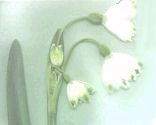 |
They were a gift from a friend. In the early spring, they brighten up the edge of the driveway with their little white blooms swinging in
They usually bloom about the end of February in U S A zone 7/8
I will try to get a better scan later.
|
It grows from small bulbs similar to jonquil bulbs
and once they are planted, can be left to themselves for years.
They are not rapid multipliers, but will form nice clumps. They
will do well in sun or part shade. Slugs love them..but they love any
green suculent plant! A good area to put the slug baits.

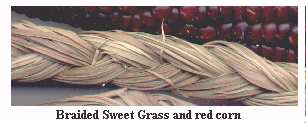 SWEETGRASS
Sweet grass is a long slender grass with a wonderfully sweet aromatic scent. Used in ceremonies by the Native Americans. It can be burned to cleanse the air and leave a good clean scent.
The scent is released into the air when dampened or burned. It is said that when the grass is smoked or burned with prayers, that the prayers are carried on the air with the smoke and carried on up into the heavens to the Great Spririt. It is also used to make baskets.
|

THYME
 scan of thyme sprigs
scan of thyme sprigs
Thyme is one of the most important herbs in a chef's cabinet.
Scampy sauce is improved with just a tad added. Soups, stews,
dressings.. It can be used in nearly any dish and makes an
excellant tea. An appetite stimulator, it can be added to many
appetizers, which use vegetables, meats, poultry, fish or other game. Like the rest of the herbs, use sparingly as it is potent. Always introduce the herbs in the last 15 minutes of cooking to keep them from getting bitter.
Thyme is beneficial to promote good circulation, and some should
be included in the diet frequently. Make tea with it or sprinkle a bit in the stew pot. It is used in what the chefs call
'bouquet garni' which also includes bay, parsley and sometimes
oregano or sweet marjorum.
There are as many different varieties of thymus as there are mints.
Get several types and try them all out! The lemon thyme is particuarly good with fish.
|

TUSSIE-MUSSIES, NOSE-GAYS AND BOUQUETS
These frivolous little fragrances were very popular in
Victorian days, and are still used at weddings, gifts for
patients, and just to give one's nose and spirits a lift.
Gather herbs and flowers, tie them into a tiny bunch, cut a
white lace paper doily down one side, wrap it around the
bouquet and tie with pretty ribbons. To be authentic, try to
find some elecampane (Lnula belenium) for the center.

VIOLET
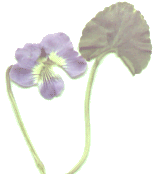 My first violet of the year 1996!
My first violet of the year 1996!
I went out to see what was coming up this morning, Feb 26th, and
there was this one itsy bitsy violet blooming! Lots of the plants
coming up, but just this one bloom in the violet bed! This way, by
scannning it, it will always be!
Dorothy gave me three violet plants from her natural garden spring of '94.......there is now about 3 or 4 hundred!...Well, no, I didn't count them, but trust me...there are a *bunch* of them. I don't know whether to celebrate or cry! I love violets and they do make a pretty ground cover. They like the shady area where they are. What I can't figure out is *how* did they propagate so rapidly?? There were only a few blooms on the 3 plants in the spring of '94! It's almost as if they sent out *spores* ! I never saw a seed! ...hardly a blossom. Any one have an idea?
They are pretty useful, if we used them for what they are good for! The blooms can be candied and eaten by themselves or sprinkled on cakes or cookies, icecream, pudding..use your imagination.. Use them, unsugared, as garnish on salads and soups..or any dish for that matter. Make a syrup of the blooms by bringing a cup of water to a boil, put about 2/3 cup of blooms in it and let steep for about 24 hours. After straining, add about 1 1/3 cup sugar to the liquid and heat enough to dissolve the sugar. *Do not* boil it. The syrup will stay a pretty color if you don't let it come to a boil. Allow to cool and store in suitable bottle. Label. If you don't want to make that much, figure about 2 units of blossoms to 3 units of water then 1 part sugar to 3 parts of liquid. This will make it about like a 'simple syrup' consistancy. It can be made heavier by adding more sugar, but it would be really heavy syrup. Incidentally, the 1 to 3 ratio is about what the San Diego Zoo recomends feeding hummingbirds. But..don't put anything but sugar for the humming birds. If you do, it will go bad and mildew.
This syrup is said to be beneficial as a gentle laxative and also to help alleviate the symptoms of colds, such as headache, coughing, and bronchitus.
The fresh leaves are useful as a poultice on bruises. Clothes can be soaked in a decoction of either fresh or dry leaves for a poultice, too.
|
ABOUT THE BEE AT THE TOP OF THE PAGE: It is a honey bee, and
definitely one of the most benificial insects in the world. Without
the bees and a meriad of other pollinators, we would have no flora.
Keep this in mind when you decide to use insecticides in your yard.
Remember, the insecticide can't decide what not to kill. It kills
what ever comes in contact with it or eats it.. the beneficials as
well as the pests.

|
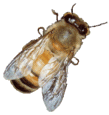 HERBS & OTHER PLANTS
HERBS & OTHER PLANTS
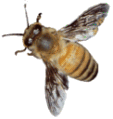
 HERBS & OTHER PLANTS
HERBS & OTHER PLANTS
